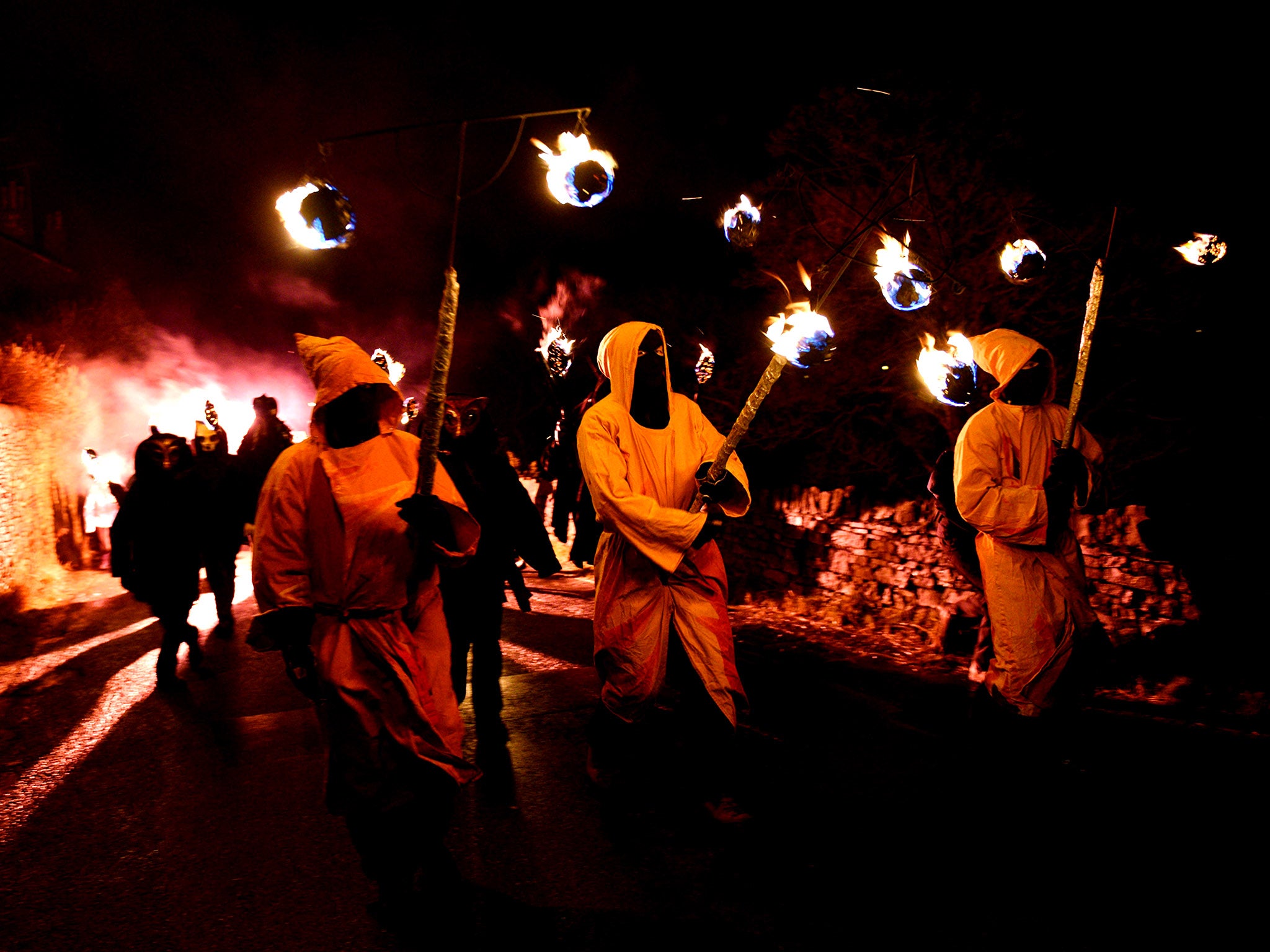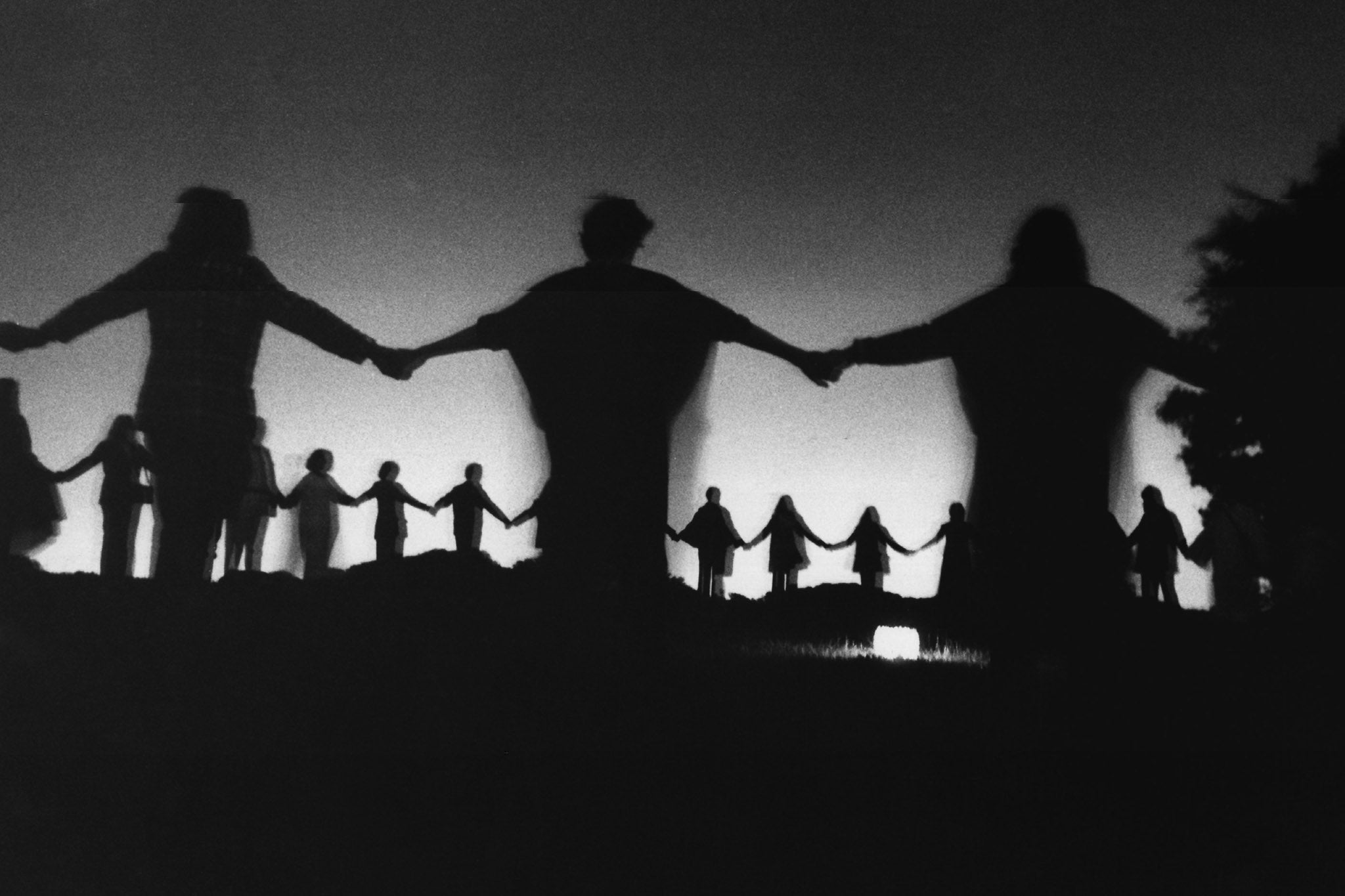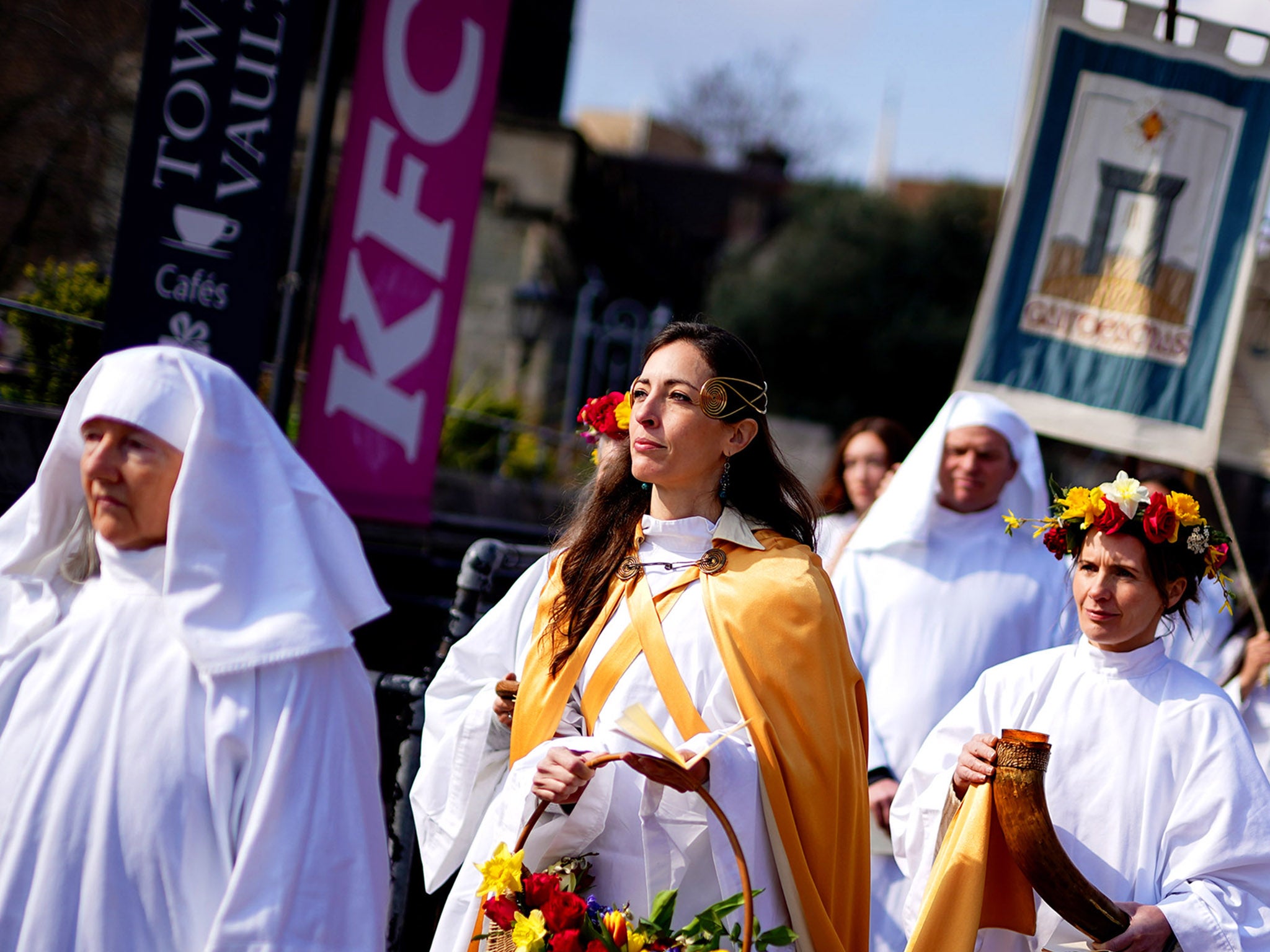What the resurgence of druids says about spirituality today
Druids were the high priests of ancient British tribes but disappeared for more than a thousand years. Today, a new generation of people are identifying as druids. Len Williams asks why

Every morning Larisa White walks out her door to greet nature. “I call it ‘going out to say hello to my people’,” she says. As a druid living in California, White’s spiritual practice follows the rhythms of the seasons. “I celebrate the first day when the fog bank of summer rolls in… the first rains… and also the first flowers, which in California come out towards the end of January.”
She also celebrates the equinoxes (twice a year when the sun crosses the equator). “I personally love the equinoxes because those are the only two moments where every person on the planet shares the experience of equal hours of day and night. I like thinking about those moments as moments of connection with the rest of humanity.”
While White stresses that her practice is not necessarily representative of all druids, her rituals provide a fascinating insight into the modern manifestation of an ancient tradition. White recently published a study into Druidry around the world. Although the religion traces its roots to the British Isles, her survey received responses from more than 700 druids in 34 countries. It’s impossible to say exactly how many people identify as druids today, but White gives an educated guess of somewhere between 60,000 and 100,000, with most living in English-speaking countries.
The curious thing about Druidry is that we know almost nothing about what ancient druids believed. There are no writings left by Iron Age druids themselves, and the only historical accounts we have are from outsiders. Druids more or less disappeared in Britain by the seventh century until scholars began to “rediscover” the British Isles’ ancient religions in the late 1700s.
So who are today’s druids, and what do they believe?
Beyond Asterix and Obelix
The first time I ever heard of druids was when reading Asterix the Gaul as a child. In the books by French cartoonists Goscinny and Uderzo, Getafix, the village druid, would simmer up a magical potion which gave the plucky Asterix and his pals the strength to defeat hordes of invading Roman legionnaires.
While the Getafix character is a comic creation, his clothing, beard and magical powers are based on historical descriptions provided by, among others, Julius Caesar. Writing about his campaign in Gaul (modern day France) around 50BC, Cesar reported that Druidry had been imported to the region from Britain. He describes druids as people “in charge of all religious matters, superintending public and private sacrifices, and explaining superstition”. The druids adjudicated in disputes, oversaw religious ceremonies and acted as power brokers.

The druids were also partial to human sacrifice, as recreated in 1973 horror movie The Wicker Man. Cesar recounts that they “make images of enormous size, with the limbs woven from osiers [willows]. Living human beings are fitted into these and, when they are set on fire, the men are engulfed in the flames and perish”.
There are a couple of other ancient writers who have described the druids. “But here's the problem,” says Ronald Hutton, a historian at the University of Bristol who has written several books on Druidry. “Everything we know about ancient druids consists of comments made by outsiders – Greeks and Romans – and there aren't many of these.” It’s possible that none of the ancient descriptions are eyewitness accounts, “so we have no idea how reliable they are”. Hutton explains that some of these ancient commentators described druids as people of great wisdom and benevolence, while others depicted them as bloodthirsty barbarian priests “with a particularly tacky line in human sacrifice”.
Druidry was largely forgotten about in Britain for at least a millennium. But then, during the Renaissance, classical descriptions of ancient Britons began to be translated into English
With the arrival of Christianity in western Europe, Druidry and pagan religions were suppressed and eventually disappeared. Almost nothing remained of druids, their beliefs or rituals. Even archaeological sites such as Stonehenge, popularly associated with druids, weren’t definitely built or used by these people. So, Druidry was largely forgotten about in Britain for at least a millennium. But then, during the Renaissance, classical descriptions of ancient Britons began to be translated into English. Scholars of the time started to develop an interest in ancient British cultures, scouring mediaeval and classical sources as well as Welsh and Irish literature. Nevertheless, the lack of direct historical sources meant druids remained a mystery.
That is until Edward Williams, a Welsh Unitarian and Mason came on to the scene in the early 1800s. Williams, who sometimes went by the name Iolo Morganwg, claimed to have discovered evidence of the rituals, beliefs, prayers and even an alphabet created by the ancient druids. The problem, however, was that Edwards was a fraud, and his “discoveries” were a product of a lively imagination.

Nevertheless, his compelling descriptions of traditional cultures in the British Isles inspired a number of Victorian organisations to call themselves druids. Similar to Masonic orders, these druids were mainly men and operated “friendly societies”, running charities and what we might call networking groups today. Indeed, in 1908 a young Winston Churchill signed up to one druid lodge.
“Each generation gets the Druidry they deserve,” suggests Graham Harvey, a researcher at the Open University who has studied neopagan religions in the UK. In the 1960s a new generation of druids emerged, in tandem with the general rejection of traditional religion of that decade. The 1960s druids espoused a diverse and eclectic set of beliefs, incorporating elements of animism, veneration of ancient deities, as well as drawing on traditional folk music and celebrations.
Since then, Druidry has evolved again, and the belief system seems to have now coalesced around respect for the natural environment and all the living beings in it. White, the druid from California, explains that in her research she found that a respect for the seasons and desire to steward and protect the environment was common among druids worldwide.
White points to other things that differentiate Druidry from other belief systems. While most religions “began with a single textual source or a single prophet”, whose ideas spread through a population, druids’ spirituality has drawn on interpretations of many ideas about what ancient druids believed. However, “gradually these have converged to become a core set of practices that are really universal for druids across nations all over the world”. Besides caring for the environment, druids celebrate the equinoxes, solstices and other seasonal changes. They also study various religious texts and books about Druidry.
Sadly, her study also revealed that some druids have faced persecution for their beliefs. While many druids are open about their faith, others keep their spiritual lives private out of fear of losing their jobs or being discriminated against in other ways.

Besides belief and study, a religious faith is also about performing rituals. According to Ronald Hutton, the historian, a standard druid ritual might involve “gathering in a circle [usually outdoors] before invoking the spiritual power of the four elements”. Hutton has attended numerous druid ceremonies as part of his research, and says there’s “usually an invocation of spirits of the land, a reference to the ancient people who lived there and sometimes people venerate a variety of deities depending on the flavour of Druidry that interests them”.
Hutton reckons that people attracted to Druidry today “are fuelled by … the feeling that there's something sacred and beautiful in nature, and a desire for individual self-expression”. As a result, many druids are involved in ecological conservation in some form or another. White, for instance, has been restoring a damaged ecosystem near her home for the past two decades.
In Wales, part of this effort to develop a national identity involved using the idea of druids as the ancient people of that part of Great Britain
This is all very well, but I struggle to get my head around the fact that druids implicitly (or even explicitly) acknowledge that their faith is, well, a recent invention. Since there is no uninterrupted link to pagan religions in western Europe, and given the lack of information about druids in the ancient world, it's difficult to see why people have chosen to identify with a set of ideas that have quite clearly been created by humans in recent history.
Unlike religions with a charismatic founder or which are based on ancient texts, druids don’t seem to claim a historical, single truth. Nevertheless, interest in Druidry seems to be growing fairly rapidly, albeit from a low level. What does this tell us about faith in the 21st century?
Harvey points out that Druidry “fits the age we live in. It's diverse, it's [about] identities, and it's about things you make for yourself.” In contemporary society, the argument goes, people are able to pick and choose identities in a way our grandparents and great-grandparents simply couldn’t. From subcultures to fashion to diet, through to belief systems and spirituality, people can select (or reject) ideas that make sense to them. Rather than simply being born into a faith, people pick and choose bits and pieces of spirituality which appeal to them, while rejecting the dogmatism of organised religion (there are apparently Christian and Buddhist druids).

Robert Saunders, a professor at a New York University who studies neopaganism, explains that for many people the appeal of these ancient religions is that they throw off the “boring and restrictive religion” of their parents. For many, he says, exploring Druidry, Wicca or similar faiths, feels like a way of reconnecting with a “more authentic”, ancient and pre-Christian religion that they feel has always been there in the background, just waiting to emerge.
Cool druids
As with any other faith or identity, Druidry has also been co-opted at various times for political ends. Saunders explains that some of the earlier interest in Druidry emerged as people began to forge national identities in Europe. “If you want to make a nation, you have to imagine it first,” Saunders argues. In the late 1970s and early 1980s many of Europe’s nation states were being formed. Rulers were pulling together people from different linguistic, cultural, ethnic and geographical regions, under the banner of newly created nation states.

To help generate a sense of national identity, political elites would “cherry-pick certain identity aspects to create nations that were usually in opposition to some other nation”. In Wales, for instance, part of this effort to develop a national identity involved using the idea of druids as the ancient people of that part of Great Britain – in opposition to Anglo Saxon peoples. By claiming an ancient link to the “original” inhabitants of a land, Welsh nationalists could claim legitimacy for the new nation. Out of this movement emerged the Eisteddfod, an annual celebration of Welshness celebrated across the country to this day (as well as by druids).
As with any religious belief, people have used neopagan religions such as Druidry for darker motives too. Since neopagan religions are often tied to ethnic and geographic identities (ie, people with a Celtic ancestry), these religions can attract and be used by people with racist or anti-immigrant beliefs – the idea being that they’re exclusively belief systems for white people of northern-European heritage. Saunders does stress that most druids and other neopagans wholly reject racism.
That said, unlike some other spiritual movements which emerged from the 1960s counterculture, Druidry seems to have avoided many of the worst excesses of “new” religions. Since Druidry isn’t inspired by a founding prophet, a central text, or even one specific deity, Saunders says it has been hard to impose any kind of strict hierarchy on the religion. While druid orders exist, hierarchy is limited and the religion doesn’t seem to be associated with any exploitation (be that financial or sexual) by powerful leaders – as has been the case with other new religions.
While I can't see myself donning white robes or attending the winter solstice at Stonehenge as a druid myself, I can understand why it might appeal to some. Tuning into the seasons, respecting the natural world and seeking wisdom all seem like worthy things to do – and if people decide to do so under the banner of Druidry, well, why not?




Join our commenting forum
Join thought-provoking conversations, follow other Independent readers and see their replies
0Comments